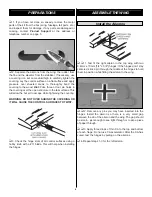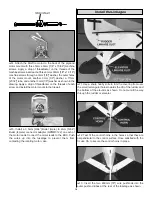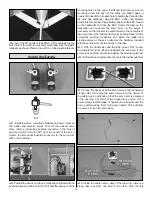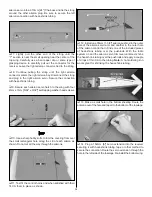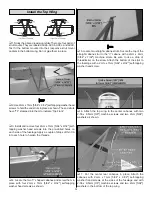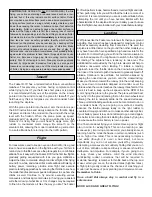
The Fokker D.VII has a tail skid rather than a conventional
tailwheel. This prevents you from having complete control
while trying to taxi. If your field has short grass or is paved,
it is recommended that you set the airplane on the runway
pointed into the wind to ready the plane for takeoff. If your
field has very thick or tall grass you should consider hand-
launching the airplane.
With the plane pointed into the wind, arm the motor as per
the ESC instructions and slowly advance the throttle. Apply
full power and launch the model into the wind with the wings
level with the horizon. When the plane picks up speed,
gradually add “up elevator” to begin a gentle climb. At this
moment it is likely that you will need to apply more right
rudder to counteract motor torque. Be smooth on the
elevator stick, allowing the model to establish a gentle climb
to a safe altitude before turning into the traffic pattern.
For reassurance and to keep an eye on other traffic, it is a good
idea to have an assistant on the flight line with you. Tell him to
remind you to throttle back once the plane gets to a comfortable
altitude. Take it easy with the Fokker D.VII for the first few flights,
gradually getting acquainted with it as you gain confidence.
Adjust the trims to maintain straight and level flight. After flying
around for a while, and while still at a safe altitude with plenty of
battery power remaining, practice slow flight and execute
practice landing approaches by reducing the throttle to see how
the model handles at slower speeds. Add power to see how she
climbs as well. Continue to fly around, executing various
maneuvers and making mental notes (or having your assistant
write them down) of what trim or C.G. changes may be required
to fine tune the model so it flies the way you like. The Fokker
D.VII will perform loops, hammerheads, inverted flight and rolls.
When performing rolls you will find that the rolls are more of a
barrel roll. It is recommended you are at a safe altitude before
attempting the roll until you have become familiar with the
characteristics of the airplane. Mind your battery power but use
this first flight to become familiar with your model before landing.
WWI planes like the Fokker are notorious for their poor ground
handling. Your model has been designed for maximum control
without excessively deviating from scale lines. This said, the
airplane is a little trickier on the ground than other models you
may have flown. We have specified a high and low rate for the
elevator. For normal flying you will find the low rate elevator is
more than adequate. You might want to switch to the high rate
for landing. The airplane has a tendency to nose over. The
additional throw provided by the high rate elevator will help to
minimize nose-overs when landing. To initiate a landing
approach, lower the throttle while on the downwind leg. Allow
the nose of the model to pitch downward to gradually bleed off
altitude. Continue to lose altitude, but maintain airspeed by
keeping the nose down as you turn onto the crosswind leg.
Make your final turn toward the runway (into the wind) keeping
the nose down to maintain airspeed and control. Level the
attitude when the model reaches the runway threshold. At this
point it is best to keep up the air speed and the RPM of the
motor, flying the plane to the ground. The plane will land best
if you fly it to the ground landing first on the main wheels and
allowing the tail to naturally settle as the speed decreases.
Three point stall landings will also work but are trickier to do on
a consistent basis. If you are going to overshoot, smoothly
advance the throttle (always ready on the right rudder to
counteract torque) and climb out to make another attempt. But,
if your battery power is low, do not attempt to go around again.
It is better to land long than risk stalling the plane by flying too
slow because the motor battery is low on power.
One final note about flying your model: Have a goal or flight
plan in mind for every flight. This can be learning a new
maneuver(s), improving a maneuver(s) you already know, or
learning how the model behaves in certain conditions (such
as on high or low rates). This is not necessarily to improve
your skills
(though it is never a bad idea!), but more
importantly so you do not surprise yourself by impulsively
attempting a maneuver and suddenly finding that you’ve run
out of time, altitude or airspeed. Every maneuver should be
deliberate, not impulsive. For example, if you’re going to do
a loop, check your altitude, mind the wind direction
(anticipating rudder corrections that will be required to
maintain heading), remember to throttle back at the top, and
make certain you are on the desired rates (high/low rates).
A flight plan greatly reduces the chances of crashing your
model just because of poor planning and impulsive moves.
Remember to think.
Have a ball! But always stay in control and fly in a
safe manner.
GOOD LUCK AND GREAT FLYING!
Landing
Flight
Takeoff
CAUTION (THIS APPLIES TO ALL R/C AIRPLANES): If, while
flying, you notice an alarming or unusual sound such as a low-
pitched “buzz,” this may indicate control surface
flutter. Flutter
occurs when a control surface (such as an aileron or elevator) or
a flying surface (such as a wing or stab) rapidly vibrates up and
down (thus causing the noise). In extreme cases, if not detected
immediately, flutter can actually cause the control surface to
detach or the flying surface to fail, thus causing loss of control
followed by an impending crash. The best thing to do when flutter
is detected is to slow the model immediately by reducing power,
then land as soon as safely possible. Identify which surface
fluttered (so the problem may be resolved) by checking all the
servo grommets for deterioration or signs of vibration. Make
certain all pushrod linkages are secure and free of play. If it
fluttered once, under similar circumstances it will probably flutter
again unless the problem is fixed. Some things which can cause
flutter are; Excessive hinge gap; Not mounting control horns
solidly; Poor fit of clevis pin in horn; Side-play of wire pushrods
caused by large bends; Excessive free play in servo gears;
Insecure servo mounting; and one of the most prevalent causes
of flutter; Flying an over-powered model at excessive speeds.

